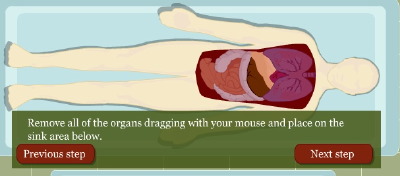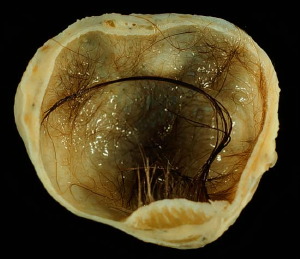Medicine
Eye Worms
Ear Worms is the term for those annoying songs that get stuck in your head. Eye Worms, on the other hand, are simply worms that burrow through your eye. Their scientific name is Loa loa filaria. You get them from fly bites. All About Worms has some more info:The video below seems to be an attempt to combine ear worms and eye worms. It shows the removal of an eye worm from a patient, set to a cover version of Top of the World by the Carpenters:
Posted By: Alex - Thu Jan 29, 2009 -
Comments (7)
Category: Medicine
Squeekums the Rat Mannikin
 Fully articulated and extremely realistic. Comes with detachable tail and the capability of IV access at the caudal vein site. Also, replaceable ear sets. Price: only $729.
Fully articulated and extremely realistic. Comes with detachable tail and the capability of IV access at the caudal vein site. Also, replaceable ear sets. Price: only $729.Or you could trap a real one outside for free. Seem to be plenty in the alleyway behind my house.
Posted By: Alex - Wed Jan 21, 2009 -
Comments (7)
Category: Animals, Medicine
Dr. Seth Arnold’s Great Infantile Regulator
For Christmas this year, I received Picturesque Rhode Island, an 1881 guidebook to my native state. I love such antique manuals, as they often hold quaint forgotten information about familiar places.
(Looking online, I discover that the entire book has been digitized here, so that you can have your own virtual copy.)
The front and back sections of the volume are full of ads. Here are two for some nostrums that I am sure contained plenty of dope.
No wonder the citizens in the drawings all look so relaxed and peaceful!
Posted By: Paul - Tue Jan 20, 2009 -
Comments (11)
Category: Medicine, Regionalism, Advertising, Products, Babies and Toddlers, Nineteenth Century
Expensive Pets
Alex's post on animal owners seems to have divided WU readers into two camps: those who would pay any sum to heal their pet, and those who would duct-tape a gerbil at the first sign of infirmity.I'm sure both types of readers would like to learn about the experiences of Kim Cavallero.
Due to myriad health issues, Kim Cavallero has racked up more than $20,000 in veterinary bills for her cat, Annie, in the past year. Through the employee assistance program at her job, she discovered Feline Outreach. "During a time when people thought I was crazy for continuing to care for my pet through very serious and expensive medical care, Feline Outreach validated me -- especially emotionally,'' she said. "With their grant, they let me know that I was doing the right thing for my cat.''
Posted By: Paul - Mon Jan 12, 2009 -
Comments (12)
Category: Animals, Medicine, Money
Interactive Autopsy
Learn how to perform an autopsy at the Interactive Autopsy site. First, make the Y-incision. Saw off the ribs to expose the internal organs. You may remove all the organs at once (which is known as the Rokitansky method). etc., etc.My favorite part was weighing the organs.

Posted By: Alex - Wed Jan 07, 2009 -
Comments (3)
Category: Death, Medicine
Freddy Flossisaurus

Cheap stuffed puppet: $10.00
Fake dentures from gag shop: $5.00
Toothbrush: $1.00
Total cost of teaching device: $16.00, max. And that's paying retail!
So why does Freddy Flossisaurus cost $316.00 at this medical-supply site!?!
[edit: checking back in 2012, it appears that Freddy is sadly no longer for sale. So I removed the link. -Alex]

Posted By: Paul - Wed Dec 31, 2008 -
Comments (4)
Category: Body, Education, Medicine, Toys
The Surprise Question

In medicine the "surprise question" has a specific meaning. It refers to when a doctor asks himself this question: "Would I be surprised if this patient died in the next year?"
A recent study published in the Clinical Journal of the American Society of Nephrology found that the surprise question has high predictive value. Doctors classified 147 dialysis patients into "yes" and "no" groups on the basis of the surprise question. (i.e. No, I wouldn't be surprised if they died.) Sure enough, the No group died within the next year at a rate 3.5 times higher than the Yes group.
Conclusion: "The 'surprise' question is effective in identifying sicker dialysis patients who have a high risk for early mortality and should receive priority for palliative care interventions."
Posted By: Alex - Tue Dec 30, 2008 -
Comments (9)
Category: Death, Medicine
Foot in Brain
A colorado surgeon found a tiny foot, hand, thigh, and parts of an intestine growing inside the brain of a 3-day-old baby. DenverChannel.com has a picture of the brain-foot.It's not clear whether this was a case of "fetus in fetu" (a fetus growing inside its twin) or fetiform teratoma (a kind of tumor).
Wikipedia has a good article on Teratomas, noting that teratomas have been reported to contain "hair, teeth, bone and very rarely more complex organs such as eyeball, torso, and hand." There was even one case of a mature teratoma being "reported to contain a rudimentary beating heart."
For your entertainment, here's a photo (from Wikipedia) of a cystic teratoma containing hair.

Posted By: Alex - Thu Dec 18, 2008 -
Comments (5)
Category: Babies, Body Modifications, Medicine
Self-Embedding Disorder
Teenagers have discovered a new method of screwing themselves up. Cutting and poisoning themselves is no longer enough. The new fad is to deliberately embed objects in their flesh. Doctors report that they've removed a variety of embedded objects from the arms, hands, feet, ankles and necks of teenage girls. These objects include: needles, staples, wood, stone, glass, pencil lead, crayon, and an unfolded metal paper clip more than 6 inches long.Goes without saying that the teenagers doing this have a lot of mental health issues. Link: Chicago Tribune
(I'm pretty sure someone forwarded us this link, but I can't remember who it was. Thank you, whoever you are!)
Posted By: Alex - Wed Dec 10, 2008 -
Comments (4)
Category: Medicine, Psychology
Piblokto
File this under Weird Medical Conditions. Piblokto is the Eskimo word for Arctic Hysteria. From Wikipedia:From a 1965 newspaper article:
"Tearing off clothing.
"Fleeing, nude or otherwise, across ice and snow.
"Rolling in snow.
"Jumping into icy water.
"Picking up loose objects and tossing them in the air.
"Kicking all sorts of loose objects, particularly dogs.
Between Piblokto and Windigo Psychosis the Arctic sounds like a great place to spend some time.
Posted By: Alex - Mon Dec 08, 2008 -
Comments (5)
Category: Medicine

| Who We Are |
|---|
| Alex Boese Alex is the creator and curator of the Museum of Hoaxes. He's also the author of various weird, non-fiction, science-themed books such as Elephants on Acid and Psychedelic Apes. Paul Di Filippo Paul has been paid to put weird ideas into fictional form for over thirty years, in his career as a noted science fiction writer. He has recently begun blogging on many curious topics with three fellow writers at The Inferior 4+1. Contact Us |






